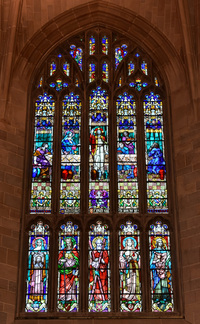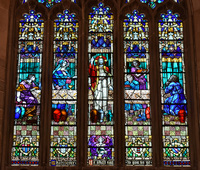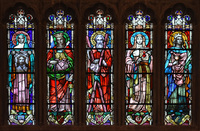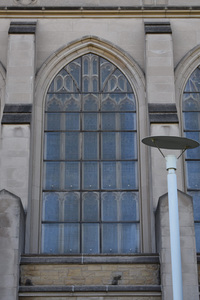Window
Building Name: Cathedral of the Most Blessed SacramentStudio Name: Willet Hauser Architectural Glass
City: Detroit
Window Shape: 6 (gothic arched, more than 2 vertical sections)
Subject/Title of Window: The Wedding Feast at Cana
Brief Description of Subject: The canopy topping this five panel window is decorative in nature highlighted by angels with a censer.
The scene below is topped with decorative inscriptions based on Matt. 28:4-5 --- the resurrection scene where the two Mary's had come to anoint the body of Jesus and an angel appeared at the tomb "And for fear of him the guards trembled and became like dead men. But the angel said to the women `Don't be afraid, for I know you seek Jesus.' " The Wedding Feast of Cana depicted here is covered in John 2:1-12. The Virgin Mary along with her son and his disciples were invited to a wedding at Cana in Galilee and the wine had run out. Mary tells her son about it but he responds that it is not my time yet, but she tells the servants "Whatsoever he shall say to you, do ye." Jesus tells the servants to fill some jugs with water and he changes the water into wine. Upon tasting this wine the master of the feast chides the groom "Why have you saved the best wine until now?" The scene uses all of the main characters -- servant, master of the feast, bridegroom, Virgin Mary, and Jesus. Below the scene are decorative coats-of-arms as befitting a Norman styled church as well as an angel holding a bunch of grapes (wine).
In the lower portion of the window is depicted five saints with the artist's creation of their coats-of-arms.
St. Veronica is known through a legend that as Jesus was carrying his cross on the way to Calvary, she handed him a cloth to wipe his face. When Jesus returned the cloth to her it had an image of his face on it. Her attributes seen here are holding a cloth with the image of Jesus and a coat-of-arms that depicts the scene at Calvary -- 3 crosses, one for Jesus and the other two for the thieves that were crucified with him.
St. Ursula and the Eleven Thousand Virgins (4th Century) According to legend she was the daughter of a Briton King. She was betrothed to a pagan king but an angel told her to delay the marriage for three years and then not marry him unless he converted to Christianity. After three years went by she went to Rome accompanied by her husband-to-be and eleven thousand virgins and then they sailed to Cologne. When he did not convert to Christianity she refused to marry him and she was killed by an arrow along with the eleven thousand virgins. Her attributes seen here are dressed as a princess carrying a scepter, pierced with an arrow, and an arrow in her coat-of-arms. Since this window was made, her feast day has been deleted from the Liturgical Calendar.
St. Andrew was a fisherman by trade and the first to become an apostle. He was martyred on a saltire -- an "X" shaped cross now popularly known as a "St. Andrew's Cross". His attribute seen here is holding a saltire which also appears in the coat-of-arms.
St Catherine of Siena (1347-1380) After a vision of Christ over the Basilica of St. Dominic she joined the Lay Fraternities of St. Dominic. It is said her heart was on fire for the love of Christ. She wrote many influential books on the Christian faith. She received the stigma of the Crown of Thorns after praying to a crucifix and was instrumental in getting the papacy moved back to Rome from Avignon. She has received the honor of Doctor of the Church. Her attributes seen here are costumed as a Dominican nun, book, flaming heart, and Crown of Thorns. In the coat-of-arms is seen a hooked wheel which is not her attribute but is the main attribute of St. Catherine of Alexandria who was tortured on one for her faith.
St. Barbara, according to legend, was born to a rich pagan father in the 3rd century. He locked her up in a tower to protect her from suitors, when he found out that she was now a Christian, he decided to kill her but she miraculously escaped into the hills. She was eventually caught and tortured with rods that miraculously turned into peacock feathers. Finally her father beheaded her and he was incinerated with a lightning bolt. Her attributes seen here are a peacock feather, a chalice which in Gothic art represented that one had converted to serve the Lord, and a crown which signifies sainthood. Since this window was made, her feast day has been deleted from the Liturgical Calendar.
From the Guide to the Cathedral of the Most Blessed Sacrament, Copyright 1958, Archdiocese of Detroit.
Here is portrayed the first public miracle of Christ when, at the request of His mother, He turns water into wine least the young newlyweds suffer embarrassment before their guests. In the center panel Christ invokes His divine power on the stone water jugs while Mary stands to the left. The words spoken by Mary to the stewards, are below: Whatsoever He shall say to you, do ye.” In the lower portion of the window are St. Veronica, St. Ursula, St. Andrew, St. Catherine of Bologna, and St. Barbara.
Inscriptions: Mhatsoever (sic) He shall say to you do ye (the piece of glass for the "W" was put in upside down turning it into a "M").
Height: 25'
Width: 12'
The Wedding Feast of Cana
The Wedding Feast of Cana scene
The Wedding Feast of Cana, Saints
The Wedding Feast of Cana outside
The MSGC is a constantly evolving database. Not all the data that has been collected by volunteers has been sorted and entered. Not every building has been completely documented.
All images in the Index are either born-digital photographs of windows or buildings or are scans of slides, prints, or other published sources. These images have been provided by volunteers and the quality of the material varies widely.
If you have any questions, additions or corrections, or think you can provide better images and are willing to share them, please contact donald20@msu.edu






